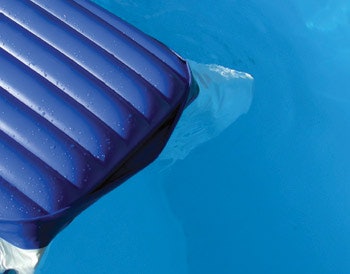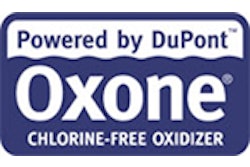
If perception is reality, then some homeowners may need your help adjusting how they see pool maintenance with a salt chlorine generator. While pools with these generators do typically require less maintenance than a traditionally chlorinated pool, there's still a little work involved.
Whether you're selling, building or maintaining pools with salt chlorine generators, it's important to pass on clear instructions about the care of these pools to homeowners.
AQUA asked Brian Van Bower, owner of Aquatic Consultants in Miami, Fla., and a Genesis 3 Design Group founder, about his experience with this equipment and what he tells clients about care and maintenance.
Q: How long have you been specifying salt chlorine generators?
A: We've been doing chlorine generation salt conversion systems on almost every project for about 18 years, and we have changed our approach and specification repeatedly as new developments came along. So obviously, we believe in them or we wouldn't be putting them on all these pools, and when we do install chlorine generation salt conversion systems, there's a couple things we like to clarify with clients.
Our belief is that with these systems, the biggest attribute is the water quality, more so than saving money by not buying chlorine. Certainly you wouldn't buy chlorine, but you do buy a piece of equipment and you're going to have maintenance on the equipment, so we don't promote the savings part much.
We're more into the water quality. When I talk to clients, I tell them that with the chlorine generation salt conversion system, the water is very soft, even though it's a minimal amount of salt. And we try to correct our client's expectations of salt because people say, "I want one of those salt pools," and they may have heard about them but may not really understand them.
We always want to be sure they understand we're talking about 3,000 ppm of salt, which is half the strength of a human tear in salinity, and nowhere near the salinity of ocean water, which is around 35,000 to 40,000 ppm salt. We want them to know that, and we tell them water quality is the No. 1 benefit because there's enough salt that the water does feel soft and silky. And it's extremely eye friendly because the chlorine is produced at a higher pH than say with the chlorine tablets where they're driving the pH down.
Q: Do you ever use ozone with these salt systems?
A: On probably a third of the projects we do today, in addition to the salt system, we add the component of ozone to the mix, and we do that because we like some of the qualities of the ozone generators as far as reducing the amount of chlorine necessary in the first place. A lot of clients have the misperception that somehow a salt chlorine-generated pool is chlorine free, and of course we know that's not true; but on the other hand, a lot of people who swim in a salt chlorine- generated pool feel like they're swimming without chlorine so that's where that comes from and I guess that's a good thing that that occurs. So we add ozone on a lot of our salt pools because it reduces the amount of oxidizer you need from the chlorine. The system we use most of the time is AutoPilot and they make an add-on called CoPilot, which is an ozone generator, which hooks up to the same system.
Typically, we specify a chlorine generation salt conversion system and AutoPilot's Total Control because earlier versions of salt chorine generators had a dial that you set that dictated how much it ran, and then you had to monitor it and keep playing with the dial until you thought you had it in the right range, and obviously that would change at different times of the year based on pool use and weather. However, the Total Control unit uses an ORP sensor to turn the unit on and off.
For years now we've been using the Total Control unit so all that adjusting the dial went out the window, and now with the ORP sensor, it only turns the unit on when the water goes lower than the ORP setting we've put into the system.
We tell clients we think this is the best system out there, but we're also realistic in our approach and tell clients that nothing is perfect. We know of nothing that you would want to put on a pool and then leave for Europe for six months. Yet we find this to be a good system.
Q: How do you prevent the pH from creeping up, since chlorine generators typically produce chlorine at a pH somewhere between 7.8 and 8.0?
A: The Total Control unit has a pH sensor, and with that sensor and a 15-gallon vat of muriatic acid, which has a peristaltic pump on it, acid is sent into the pool when the pH gets too high, thereby adjusting the pH.
On a regular basis, you just have to fill the vat with acid, which you want to store outside or in a well-ventilated place so acid fumes aren't eating up pumps and electronic equipment, and that way you can eliminate the high pH, and it makes the chlorine more effective. With the chlorine more effective, the ORP goes up, which means the unit runs less, so it's a win all the way around, and it gives us really nice water quality.
If you don't have an automated system like I described, you have to adjust the pH regularly, and in addition to that, whether you have the automated system or not, you still have to make sure your water is in balance based on the Langelier Index. You still have to adjust the total alkalinity and the calcium hardness, and you still need to have stabilizer in the water, particularly in warm weather areas.
Q: Is there any other regular maintenance?
A: You also have to check the salt periodically. We tell clients they're probably going to add salt three or four times a year if it's an outdoor pool and they're in a rainy climate. When you have rain, it dilutes the salt level, and when you have heavy bather use, where there's lots of splashing and water being replaced by the autoleveling system we include on our pools, then they're going to add salt, but not a tremendous quantity, maybe a 40- or 50-pound bag at a time. They'll add the salt three or four times a year and, of course, the newer salt chlorine generators, AutoPilot and Jandy's AquaPure, they tell you what the salt content is, and so they make it a lot easier.
I think salt chlorine generators offer a certain ease, a certain level of performance that takes a lot of aggravation out of pool maintenance. From a homeowner's point of view, they can take a breath and step back. I don't want to oversell that and have them leave for six months and think everything is going to take care of itself, but I think they work really well.
Comments or thoughts on this article? Please e-mail [email protected].











































